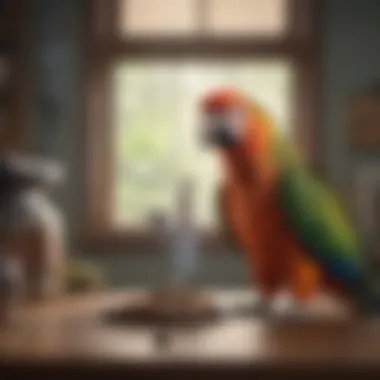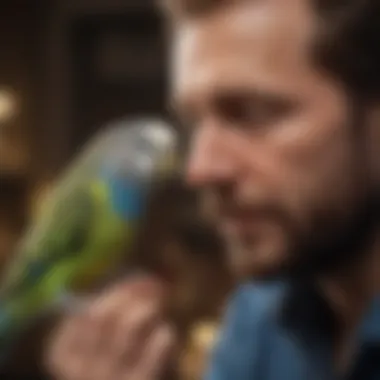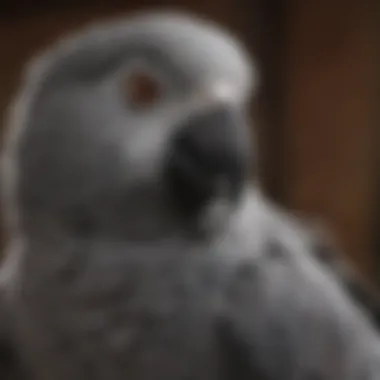The Unlikely Heroes: Pet Birds Saving Their Owners


Intro
Pet birds often bring joy and companionship to their owners. Their cheerful singings and playful antics can lighten the mood in any household. Yet, there exists a striking reality that complements their charming nature: these avian companions have been known to protect their humans in times of peril. This article explores astonishing stories of pet birds saving their owners, each case replete with astounding loyalty and earns valuable lessons about the bond between species. Through these refreshing narratives, we not only recognize the unique qualities of birds but also highlight the significance of proper care, understanding, and respect for their needs.
Care Tips
When it comes to caring for pet birds, a well-rounded approach is vital for fostering their health and strengthening the bond between pet and owner. Establishing daily practices may lead to extraordinary connections and foster behaviors that mirror sheer loyalty. Below, we delve into specific aspects of avian care that can have profound implications on their well-being, ultimately allowing for these miraculous acts of heroism.
Daily Care Routines
Daily routines form the backbone of any pet bird's care. Consistent feeding schedules, regular interaction, and exercise opportunities cater to both the physical and emotional health of the bird.
- Feeding: Provide fresh food and clean water at the start of the day.
- Interaction: Speak to them frequently to nurture social needs.
- Exercise: Allow daily out-of-cage time to promote activity and engagement.
The aim here is to maintain a familiar routine, which minimizes stress and encourages bonding behaviors.
Cage Setup and Maintenance
The cage serves as a sanctuary for a pet bird, and the setup requires thought and precision. An ideal environment must address the species’ specific needs while ensuring safety and comfort. Use the following recommendations:
- A sizable cage for the species to facilitate movement.
- Plant-based materials to construct perches for balance and foot health.
- Regularly check toys and replace any broken ones to prevent injuries.
Changing the cage setup and trying new perches or toys occasionally can stimulate the bird’s curious nature, enhancing their well-being despite the settings.
Hygiene and Cleaning Practices
Practice impeccable hygiene within the bird's environment. Bacteria and pests can flourish in neglected spaces, impacting both the bird and owner. Schedule these activities:
- Daily removal of waste from the cage floor.
- Weekly cleaning of all surfaces with safe, bird-friendly products.
- Replace bedding material regularly to keep odors at bay.
Such consistent care helps maintain a healthy ambiance for your feathered companion.
Seasonal Care Adjustments
Birds can be sensitive to shifts in temperature. Adjust for the change of seasons efficiently by monitoring:
- Temperature: Place the cage in an inner space during harsh climates.
- Lighting: Use safe lamps to simulate longer days in winter and cheerfulness during darker times.
- Humidity: Maintain proper moisture levels to safeguard respiratory health.
By being aware of environmental changes and readiness to adapt their care, owners can further secure the health and well-being of their pet birds.
Prelude to Avian Companionship
Pet birds have carved out a unique niche in the hearts and homes of many individuals, becoming essential companions. The significance of avian companionship extends beyond mere entertainment; it embodies a profound relationship often rooted in mutual dependence. In this article, we examine how these feathered creatures not only bring joy but also demonstrate capacity for loyalty and protection in ways that families and caregivers seldom expect. Understanding this multifaceted companionship is crucial when exploring the remarkable instances where birds become heroes in their own right.
The Evolution of Bird-Human Relationships
Since ancient times, humans and birds have shared a bond. Initially, essential needs connected the two, such as food and companionship. Birds served practical purposes, helping with pest control or serving as messengers. As humans began to appreciate their vibrant behaviors and vocalizations, domestication commenced. Over time, this bond has evolved, with many developing deeper emotional ties. The variety of bird species available for companionship now reflects extensive human interests in selecting traits like personality and beauty.
Statements like these serve to bond the bird and caretaker:
- Birds provide companionship.
- Their affectionate actions reinforce a social bond.
- Birds often mirror missed social interaction in their handlers’ lives.
Collectively, such elements forge a deeper understanding of their important role in human ecosystems.
Understanding the Loyalty of Pet Birds


Loyalty exhibited by pet birds is both intriguing and compelling. Unlike traditional house pets, birds may display loyalty in subtler ways. Their allegiances often manifest through protective behaviors expressed towards their owners and their living environments. These reactions stem not just from instinct but can also be attributed to conditioned responses established through consistent nurturing and positive interaction with humans.
Factors that contribute to this loyalty encompass:
- Communication: Birds often use specific vocalizations requestting attention or alerting owners to a presence.
- Attachment: Through routine calm contact, birds sense a deeper connection evolving.
- Imitation: Parrots and other species mimic human emotions, reinforcing bonds.
Through these affectionate forms of loyalty, pet birds illustrate a greater emotional depth. Owners often perceive not merely companionship but genuine friendship. Advanced relationships develop from understanding avian coc(onscisieties) and their unique requirements that nurture long-term loyalty.
Reported Incidents of Birds Saving Owners
The notion of pet birds as life-saving companions might seem far-fetched to some. However, evidence shows that birds can play crucial roles in severe situations. This section focuses on reported incidents where pet birds have shown exceptional behaviors, resulting in life-saving interventions for their owners. These stories highlight not only the bond between birds and humans but also the vital consideration of recognizing the instincts and abilities of a bird.
The most significant aspect of these incidents is the genuine nature of the birds' responses. Birds often alert their owners to perceived threats or emergencies, leveraging their strong instincts and unique senses. The ability of birds to detect changes in their environment and respond accordingly underscores the critical role they can play in household safety.
In detailing specific incidents, we can better understand the complex dynamics at play in the relationships between birds and their owners. The examples shown here delves into how these events unfold and effectively demonstrate the support pet birds can offer. By examining these case studies, readers can see firsthand the potential benefits and considerations of having a pet bird, transforming perceptions and encouraging more profound acknowledgment of their roles as protectors and companions.
Case Study: Alerting for Medical Emergencies
Numerous accounts exist where pet birds have saved their owners from medical crisis through their intuition and keen awareness. For instance, in one reported case, a parrot was central to alerting its owner during a heart attack. The bird began to vocalize loudly, mimicking the sound of its owner’s phone. While this might seem coincidental, the owner's daughter attributes the bird's calls directly to her mother's sudden health issue. This bird's ability to perceive an environmental shift, coupled with its training to recognize its owner's sounds, allowed it to both alert family members and provide timely assistance.
Having reliable birds in our homes can function similarly in potential situations like stroke or seizure around their owners. Their incessant vocalizations can draw attention, making timely medical response possible. Understanding birds' capabilities in recognizing distress clearly portrays their worth in tightly-knit human and avian environments.
Case Study: Preventing Domestic Accidents
The case of a quaker parrot illustrates the role of avian companions in preventing domestic accidents. The bird was known for several behaviors, including lighting up the house whenever family members left the door open. One day, when one family member accidentally left porcelain objects nearby, the quaker parrot began shrieking and diving towards them, demonstrating protective behavior typical of birds trying to guard their home environment.
People might question how effective a pet can be in avoiding household mishaps. The situation went beyond playful antics. The keen observation of an animal grounded in instinct helped avert a catastrophe that could affect safety and property. The little parrot not only exhibited heightened vigilance but also communicated that danger loomed.
To unify understanding between owners and their pet's instincts is key in ensuring a safer environment. Little do people realize that a bid can outweigh preventive measures by asking for collective awareness of various accidents around the house connections finding familiar triggers embedding typically concerning assign their actions and willingness to caution others can count on their presence.
Case Study: Acting as Emotional Support
Pet birds increasingly go beyond functional roles, making significant impacts on emotional well-being. Emotional distress is common, and pet birds communicate in ways that resonate deeply with individuals facing mental health challenges. Many pet owners have reported that their birds would instinctively behave with increased affection on tough days, offering a sense of comfort that can be intensely invaluable during major life stressors.
For example, a canary was noticed actively trying to stay close to a depressed owner. It would sing softly or gently touch its beak against the owner's hand whenever it detected sadness. Such behaviours reflect a profound ability exhibited by these animals to recognize the moment mood shifts in humans.
Offering such raw emotional support sustains additional layers on previous observable instances of avian interactions within challenging dynamic contexts during evolutions of life wherein every source contributes progressively in unraveling behavioral formations taking off notions resonating around requiring bonds enhancing stability imaginings previously understood regarding relationship forms.
The synergy of intelligence and emotional connectiveness reflect on avian companionship, altering perspectives on life-saving histories presented throughout worlds blending both serenity and protection redefining moments expounding unique themes intentionally driven resolve meaningful until quite recently initially perceived against culture disposable meets outstanding relevance necessary becoming staples reaching estimated long sustainable listings approachable trending effectively articulated throughout deep sensibilities.
Understanding Bird Behavior and Instincts
Understanding the behavior and instincts of pet birds is crucial for fostering a strong owner-bird relationship. This section explores the significance of looking into their natural tendencies and communication styles.
Birds have intricate behavior patterns formed from millions of years of evolution. Learning about these instincts can enhance how we care for them. By knowing what motivates these creatures, owners can provide environments that cater to their needs. This approach maximizes their potential for affectionate and life-saving behaviors.
Here are some primary considerations in understanding bird behavior:
- Protective Instincts: Many pet birds have evolved traits that prompt them to shield their flock, or in this case, their humans.
- Social Dynamics: As flock animals, birds thrive on social interactions, which can reinforce their loyalty.
- Environmental Factors: A bird's surroundings can significantly influence its stress levels and overall behavior. A stable environment allows them to act instinctively when needed most.
By focusing on their innate behaviors, we gain insight into how to strengthen our bonds and create spaces that promote their safety and comfort.
Natural Instincts in Domesticated Birds
Natural instincts in birds are deeply rooted. Most pet birds still exhibit behaviors from their wild counterparts. These instincts manifest in actions such as foraging, vocalizing, and establishing territory.


Animal behaviorists categorize these instincts into several types, including:
- Foraging: Even in captivity, many birds will act like their wild relatives, searching for food through active exploration.
- Vocalizations: Birds communicate a variety of emotions and messages through sounds. Understanding these calls can unlock their needs and concerns.
- Territoriality: Birds may exhibit protective behaviors, particularly around their living space. Knowing this helps owners manage potential stressors, especially in multi-bird households.
Instincts play an essential role in shaping behavior. By observing pet birds engage in these natural actions, owners can better appreciate their capabilities and the underlying motives behind their life-saving episodes.
How Birds Communicate Danger
Birds have unique ways of alerting their owners to danger. Their communication, both vocal and non-vocal, offers crucial insight into their awareness of threats. Recognizing these signals can lead to preparedness when emergencies arise.
Common ways birds convey discord include:
- Alarm Calls: Birds will often produce specific sounds when they sense danger. This can alert their owners to immediate threats like fire or even an intruder.
- Body Language: Besides sounds, birds also communicate non-verbally. Fluffing their feathers, expanding their wings, or changing their posture are clear signs that should not be overlooked.
- Persistent Behavior: If a bird behaves unusually clingy or agitated, it can be an indication that all is not well in their environment.
Understanding avian communication---in both vocal and physical forms---leads to proactive awareness. Bird owners can prevent potential threats more effectively by staying attuned to their pet's expressions of concern.
The Science Behind Avian Intelligence
Understanding the science behind avian intelligence is crucial in unraveling the exceptional behaviors exhibited by pet birds. These cognitive and emotional capacities form the foundation of the ties between birds and their owners. By examining aspects like cognitive abilities and mechanisms of emotional bonding, one gains insights into how these remarkable creatures can become allies and saviors in unexpected situations.
Cognitive Abilities of Birds
Birds possess unique cognitive abilities that are often underestimated. Research shows some bird species can solve complex problems, use tools, and even count. These abilities may stem from their social environments and necessity for survival. For example, members of the corvid family, such as crows and ravens, have proven their intelligence by employing various strategies to access food. Studies on tools usage illustrate how birds can manipulate their surroundings to achieve desired outcomes.
Additionally, studies reveal that parrots have strong memory retention. They remember their surroundings and identify food sources, which is critical both in the wild and in domestic life.
Birds also communicate in sophisticated firshhs. These vocalizations not only convey immediate emotions but essential information about their environment. Their ability to understand sounds and learn language-like structures suggests a higher level of comprehension than frequently recognized. Thus, evaluating the cognitive functions extends beyond simply identifying when a bird reacts under threat. It delves into how they develop these skills through natural conditioning and social experiences.
Emotional Bonding and Recognition
Birds form emotional bonds that are deeply rooted in survival instincts. These bonds rank highly in social species. Birds recognize their fing friends and humans distinctly through sight and sound. For instance, a cockatiel may respond enthusiastically to its owner’s voice. Birds can exhibit noticeable shifts in their behavior based on their relationships, establishing preferences and aversions.
Moreover, attachment to their owners could lead pet birds to sense emotional states. Research indicates that birds can pick up on negative moods, often responding accordingly. In distressing matters, their inclination to react can translate into protective behaviors, further illustrating their innate loyalty. The psychological aspect of understanding relationships reinforces both cognitive and emotional intelligence in birds.
A deeper recognition that pet birds offer vital support within human lives demonstrates the importance of nurturing these bonds through interactive practices and environments that foster well-being.
In summary, exploring avian intelligence reveals how cognitive skills and emotional dynamics solidify the relationship between humans and those avian companions. Understanding these elements aids in promoting deeper connections. Thus, the insightful examination of bird behavior brings forth vital implications for improved care practices among bird owners.
Practical Implications of Bird Lifesavers
The role of pet birds acting as heroes in their owners' lives goes beyond heartwarming stories. There are practical implications to recognizing their capabilities and potential life-saving behaviors. Understanding these implications can help enhance relationships and optimize care practices. With informed strategies, owners can prepare for emergencies and strengthen their bond with their avian companions.
Incorporating advanced bird-care principles into daily routines can maximize the benefits of having pet birds. Proper understanding of bird behaviors not only addresses their needs but also recognizes their instincts shaped through evolution. This relationship encourages more intuitive interactions between birds and their owners.
Moreover, the practical implications reveal certain considerations. It is crucial for pet owners to appreciate how stress, environment, and social interactions influence their bird's behavior. Trying to create a well-balanced living situation provides pet birds the support needed to exhibit those loyal, protective instincts. Conclusively, enhancing knowledge about these implications has the potential to transform simple companionship into impactful engagements.
Enhancing Bird Care Practices
The first practical implication relates to enhancing bird care practices. Responsible ownership involves understanding the specific needs of different bird species. Each vital element contributes to overall health and loyalty. Key practices include proper feeding, spacious and comfortable environments, routine veterinary checkups, and mental stimulation.
- Nutritional needs vary across avian species. An appropriate diet maintains health and vitality.
- Environmental stimulation includes plenty of toys and social interaction, preventing boredom that may induce undesirable behaviors.
- Social structure is important. Giving birds time outside of their cages fosters better behavioral patterns.
Additionally, observing behaviors closely allows owners to customize care according to individual birds’ needs. Monitoring these elements can help predict normal activities and identify deviations, especially in times of emergency. As a practice, prioritizing aspects of care does not simply improve birds' lives; it enhances the bond shared between pet and owner, reinforcing loyalty within the dynamic.
Training for Emergency Situations


Training pet birds for emergency situations seems unorthodox yet beneficial. Establishing tailored training regimens allows birds to respond effectively in critical moments. This form of preparation is both comforting and practical. It aids not just the owners but also the pet itself when faced with distressing experiences.
Some training tactics include:
- Desensitization to loud sounds or sudden movements can prevent shock or fear during emergencies.
- Target training, using treats to gather birds in specific locations quickly, guides them safely away from potential dangers.
- Attention diversion techniques can be taught, allowing birds to remain calm despite chaos around them.
More importantly, consistent training builds confidence in their owners as well. Knowledge that a bird can perform these techniques fosters not only reassurance in handling emergencies but a greater understanding of the pet’s training capacity. Investment in such training encourages birds to tap into their instincts while reaping added benefits of companionship.
“The bond between birds and their owners becomes stronger when birds are kept aware of their environment and trained to respond to emergencies.”
Fostering practical implications surrounding this unique animal partnership supports a harmonious coexistence between human and avian life.
Promoting Bird Welfare and Understanding
Promoting bird welfare is crucial in comprehending the dynamics of the incredible bond between pet birds and their owners. The stories of avian heroes underline their exceptional abilities. However, this warrants a deeper dive into how bird welfare influences these relationships.
Benefits of Supporting Bird Welfare:
Enhancing the ambiance in which pet birds thrive enriches their lives and encourages protective behavior. Here are some key elements to consider:
- Mental Stimulation: Providing toys and activities seasoned with new challenges developed for birds keeps their minds active.
- Social Interaction: Birds are naturally social pocket critters. Regular interaction ensures they feel a part of the family, reinforcing loyalty.
- Clean habitat: Maintaining cleanliness in their living space promotes good health and positive behaviors. Dirty habitats can lead to stress and decrease our feathered friends’ ability to act alert in emergencies.
- Nutritional Needs: Correct diet directly impacts their energy levels and cognitive functions. Consult avian nutrition guidelines to discover the needs of specific bird species.
By focusing more on these areas, owners can foster a more positive environment suitable for avian companonions.
Positive Environments for Avian Companions
Nurturing a positive environment for pet birds requires awareness of their physical and psychological needs. This entails providing safe spaces, appropriate diets, and vibrant social interactions.
- Safety: Ensure all wayward objects, hazards, and toxic items are out of their reach, creating a secure nook for exploration.
- Varied Environment: Rotate toys and arrange the cage or room to offer fresh visuals for even small changes can stimulate their curiosity.
- Routine: Establish a predictable daily pattern for feeding and interaction. Lack of a routine can bore birds and affect their behavior.
By fostering a conscious environment, owners can evoke both trust and strong attachment, allowing birds to reveal their heroics when the moment arises.
Community and Resources for Bird Owners
Being part of a community can significantly help in promoting bird welfare. Numerous resources offer invaluable information, support, and camaraderie to bird owners.
- Online forums: Websites like forums on Reddit deliver platform where owners can share their experiences and advice about avian childcare.
- Local Bird Clubs: Attending meetings can offer one-on-one networks for learning more about bird husbandry.
- Social Media Groups: Engaging with groups on platforms such as Facebook creates a broader avenue for information and connection.
- Webinars and Workshops: Check reputable organizations for upcoming educational opportunities on birds' care and behavior. These often help enlighten and equip you with the essentials to enhance your bird's wellbeing.
By tapping into collective experiences and knowledge-sharing platforms, bird owners create networks that enhance all aspects of avian care, including potential life-saving actions.
Making use of these resources fosters deeper understanding among owners. This leads to better bird care practices. Ultimately, well-informed owners can enhance their pet birds' impacts as the unexpected lifesavers.
Ending: Celebrating Our Feathered Friends
Pet birds serve a unique role in our life, often exceeding our expectations in companionship. Their bond with humans can be profound, manifesting not just in joy and play, but also in acts of bravery under critical circumstances. Acknowledging these aspects opens up a genuine celebration of the pet birds in our homes.
Reflections on Pet Birds’ Impact on Human Lives
Birds bring unspeakable joy. Their ability to thrive in human households often promotes emotional well-being. Animals like African Grey Parrots and Cockatiels enhance social connections. Many owners report greater happiness levels, reduced loneliness, and even lower stress.
Consider the instinctive patience of a budgerigar, caring for its owner during moments of despair. This is not trivial. Scientific studies highlight the correlation between avian companionship and increased psychological benefits.
“The beauty in bird intelligence is their ability to understand human emotions,” said a bird behaviorist. The ability to connect reflects various characteristics typical to our avian companions.
Encouraging Deeper Connections with Pet Birds
Creating a stronger my fond relationship also brings benefits to birds. They respond positively to affection and trust leading to enhanced communication and interaction. Understanding their needs is critical in deepening this bond.
- Spend regular, quality time with your birds: This stimulates them mentally.
- Incorporate training sessions into daily routines: It builds trust and reinforces their skills.
- Observe their behavior: Recognizing cues and signs of distress or comfort furthers a more caring experience.
Encouragement leads to a frequency of purposeful interaction, ensuring both parties grow from their bond. Deepening connections with bird companions enriches life significantly for humans too, creating an ongoing cycle of affection.
Overall, these insights validate the relationship between humans and their feathered friends, an important avenue for appreciated loyalty and unsought heroism.















